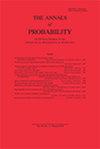Relaxation to equilibrium of generalized East processes on $\mathbb{Z}^{d}$: Renormalization group analysis and energy-entropy competition
IF 2.5
1区 数学
Q1 STATISTICS & PROBABILITY
引用次数: 22
Abstract
We consider a class of kinetically constrained interacting particle systems on Zd which play a key role in several heuristic qualitative and quantitative approaches to describe the complex behavior of glassy dynamics. With rate one and independently among the vertices of Zd, to each occupation variable ηx∈{0,1} a new value is proposed by tossing a (1−q)-coin. If a certain local constraint is satisfied by the current configuration the proposed move is accepted, otherwise it is rejected. For d=1, the constraint requires that there is a vacancy at the vertex to the left of the updating vertex. In this case, the process is the well-known East process. On Z2, the West or the South neighbor of the updating vertex must contain a vacancy, similarly, in higher dimensions. Despite of their apparent simplicity, in the limit q↘0 of low vacancy density, corresponding to a low temperature physical setting, these processes feature a rather complicated dynamic behavior with hierarchical relaxation time scales, heterogeneity and universality. Using renormalization group ideas, we first show that the relaxation time on Zd scales as the 1/d-root of the relaxation time of the East process, confirming indications coming from massive numerical simulations. Next, we compute the relaxation time in finite boxes by carefully analyzing the subtle energy-entropy competition, using a multiscale analysis, capacity methods and an algorithmic construction. Our results establish dynamic heterogeneity and a dramatic dependence on the boundary conditions. Finally, we prove a rather strong anisotropy property of these processes: the creation of a new vacancy at a vertex x out of an isolated one at the origin (a seed) may occur on (logarithmically) different time scales which heavily depend not only on the l1-norm of x but also on its direction.$\mathbb{Z}^{d}$上广义East过程的松弛平衡:重整化群分析和能量熵竞争
我们考虑了Zd上一类动力学约束的相互作用粒子系统,它们在描述玻璃动力学复杂行为的几种启发式定性和定量方法中起着关键作用。对于每个职业变量ηx∈{0,1},在速率为1且独立于Zd的顶点之间,通过投掷(1−q)-硬币提出一个新值。如果当前配置满足某个局部约束,则建议的移动被接受,否则被拒绝。对于d=1,约束要求在更新顶点的左边顶点有一个空位。在本例中,该流程就是众所周知的East流程。在Z2上,更新顶点的西部或南部邻居必须包含一个空位,类似地,在更高的维度上。尽管它们表面上很简单,但在低空位密度的极限q d d 0下,对应于低温物理环境,这些过程具有相当复杂的动态行为,具有分层松弛时间尺度、异质性和普遍性。利用重整化群的思想,我们首先证明了Zd尺度上的弛豫时间是East过程弛豫时间的1/d-根,证实了大量数值模拟的结果。接下来,我们通过多尺度分析、容量方法和算法构建,仔细分析了微妙的能量熵竞争,计算了有限盒子中的松弛时间。我们的结果建立了动态异质性和对边界条件的戏剧性依赖。最后,我们证明了这些过程的一个相当强的各向异性性质:在原点(种子)孤立的顶点x上产生一个新的空位可能发生在(对数上)不同的时间尺度上,这不仅严重依赖于x的11范数,而且还依赖于它的方向。
本文章由计算机程序翻译,如有差异,请以英文原文为准。
求助全文
约1分钟内获得全文
求助全文
来源期刊

Annals of Probability
数学-统计学与概率论
CiteScore
4.60
自引率
8.70%
发文量
61
审稿时长
6-12 weeks
期刊介绍:
The Annals of Probability publishes research papers in modern probability theory, its relations to other areas of mathematics, and its applications in the physical and biological sciences. Emphasis is on importance, interest, and originality – formal novelty and correctness are not sufficient for publication. The Annals will also publish authoritative review papers and surveys of areas in vigorous development.
 求助内容:
求助内容: 应助结果提醒方式:
应助结果提醒方式:


